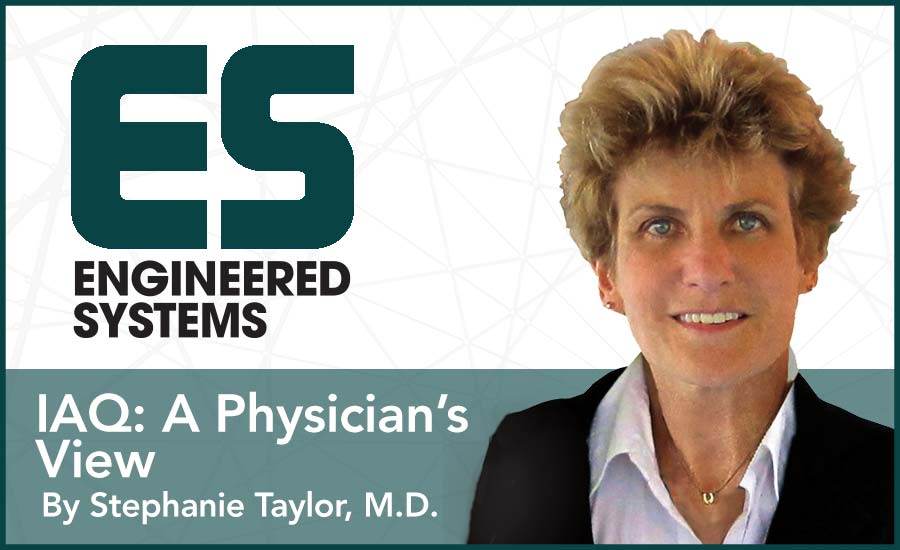During ASHRAE’s June 2019 annual meeting in Kansas City, I became optimistic that the society is truly expanding its horizons to include occupant health as an important building performance metric. This is a tremendous step forward because we spend about 90% of our time in buildings, so there is a very good chance the indoor environment is going to affect our health.
For the financially motivated reader, a cost-benefit analysis review study in 2005 found that allowing office workers to control their own IAQ resulted in up to a 60% reduction in sick-leaves and an increase in productivity of around 6.5%. The benefit-to-cost gains following the renovations needed for this self-controlled indoor-air management was a ratio of at least 10.
Another study in 2009 calculated the annual cost of sick days for a company with 100 employees who are each paid $62,000 per year. Five sick days per employee cost the company $119,879 per year, whereas one sick day per employee only cost $23,976 per year. These calculations do not even include productivity losses from “presenteeism,” the term for ill employees who choose to come to work anyway.
My optimism that ASHRAE has expanded its viewpoint to include human health is based on tangible, action-oriented evidence. This includes a new multi-task group, ongoing work in the Environmental Health Committee, the newly released document on “Allowable Humidity Excursions,” and a webcast on “Humidification, Health, and Building Performance” scheduled for the spring of 2020. Thankfully, ASHRAE’s interest in human health also includes open-mindedness to the idea that to thrive, people need some amount of water vapor in their environment. This means that indoor humidification will be necessary in many climates during heating seasons.
Clearly, understanding how the indoor environment contributes to health or sickness is consistent with the ASHRAE mission, “To advance the arts and sciences of heating, ventilating, air conditioning, and refrigerating to serve humanity and promote a sustainable world.” Despite this step forward, adding health to energy metrics is a change. History has shown us again and again that progress is usually met with significant opposition. When Nicholas Copernicus and then Galileo provided data showing that the earth revolved around the sun instead of vice versa, they were found guilty of heresy against the church and narrowly escaped execution.
What are the obstacles and pushbacks that ASHRAE might experience by adding occupant health to existing and familiar building performance metrics such as energy consumption?
Here are a few challenges that I can think of:
-
The definition of health outside of the in-patient setting has never been agreed upon. Is it simply the lack of disease or something more general? Furthermore, how will this ethereal, healthy state-of-being be measured by engineers and building managers?
-
Adding health to building metrics means that engineers, architects, nurses, and physicians will become close colleagues. Personalities will differ and those differences must be respectfully navigated.
-
Each profession will need to learn new words, acronyms, and metrics. For example, the familiar exclamation, “SOB,” also refers to “shortness of breath” in medicine.
-
Known engineering metrics, such as R-value, U-value, and joules, will be joined by CBC (complete blood count), USG (urine specific gravity), and others.
Finally, and not to be ignored, are the possible legal ramifications of researching and writing standards for occupant health. For guidance in this area, ASHRAE could learn from the medical field. In 1999, the Institute of Medicine published To Err is Human, revealing the enormous number of hospitalized patients who were harmed from medical errors. To better understand and prevent these catastrophes, hospitals began to record the steps leading up to harmful mistakes. Unfortunately, this work quickly slowed when prosecuting lawyers in medical harm cases requested disclosure of the error logs for litigation against the hospital.
To encourage hospitals to pursue safety research, The Patient Safety and Quality Improvement Act of 2005 was passed. This act established a network of patient safety organizations and a national patient safety database. To encourage reporting and peer-review of adverse events, near misses, and dangerous conditions, it also established federal confidentiality protection from legal discovery of patient data collected as part of hospital efforts to assess and resolve patient safety issues. Hospital data collected in order to reduce medical errors and improve patient safety continues to be generally exempt from legal exposure. This is an example of legislation that could provide legal protection, if needed, for ASHRAE.
Despite the challenges listed above, as illnesses, such as infections, allergies, inflammatory diseases related to particulate matter, and more, continue to take a huge toll on human life and financial resources, the opportunity to understand and curtail building-related drivers cannot be missed.
While this movement is still in its infancy, ASHRAE deserves a big congratulations and lots of support.




